Monyash
OS Grid ref:- SK149665
The Peak District village of Monyash lies in a shallow hollow in the limestone plateau at the head of beautiful Lathkill Dale and is situated about five miles west of the market town of Bakewell.
The Village Green
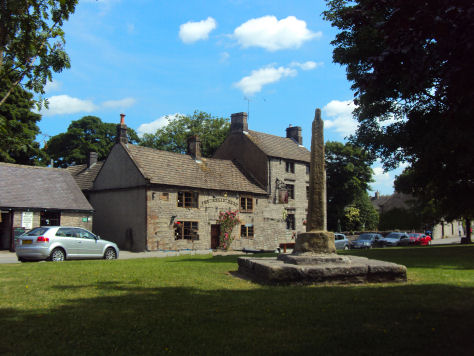
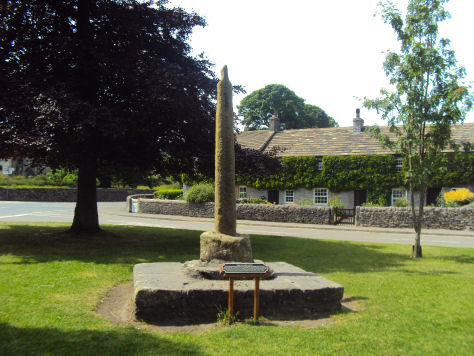
The village is mentioned in the Domesday survey of 1086, where it is referred to as Maneis, a berewick of Bakewell and in the possession of the King. The name Maneis means "many springs or waters".
The village owes much of its existence to the presence of a bed of impervious clay, able to hold water in 4 original ponds or `meres`. Only one, Fere Mere, now remains.
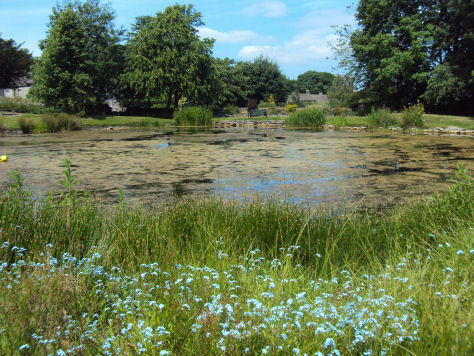
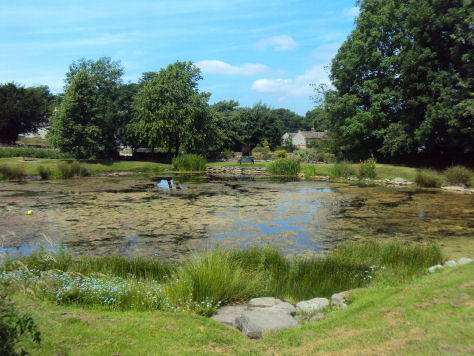
Monyash (pronounced Munyash) was once an important lead mining centre and market village, its market charter having been granted by King Edward III in 1340. The old market cross, which stands on the village green, has a base which is said to have been made from old village stocks. The 'King' and 'Queen' trees, which also occupy the village green, were planted in 1910 to celebrate the Coronation of King George V and Queen Mary.
The village church of St Leonard's was founded sometime between 1100 and 1192. It boasts a Norman piscina and sedilia and a fifteenth century font. Major enlargements were carried out around 1199, 1250, 1348 and 1370, followed by two major restorations in 1886-1888 (by William Butterfield) and 1996-2006. The parish chest, which measures 10 feet in length, probably dates back to the thirteenth century when it was used to store the altar plate.
St Leonard's Church and the Bull's Head Inn
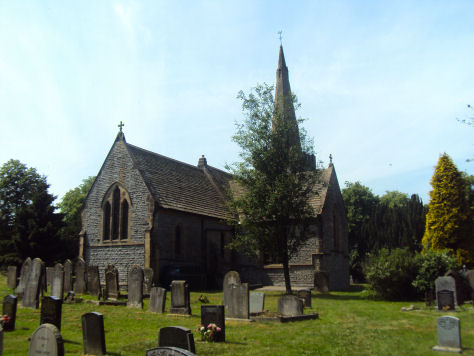
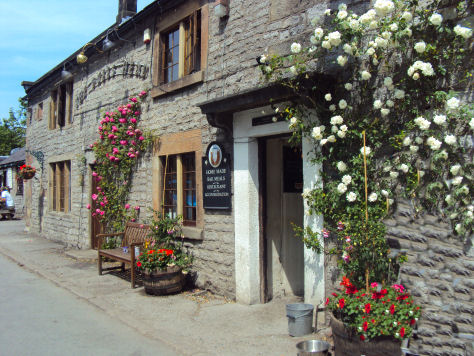
John Gratton (1640–1711), who encouraged the development of the non-conformist movement, lived in the village for 34 years, and from the late eighteenth century Monyash became a Quaker stronghold, often visited by the Radical Quaker statesman, John Bright.
There is only one pub in the village, the Bull's Head, which stands next to the village green. The building dates from the late seventeenth/ early eighteenth century and is one of the oldest buildings in the village. The pub has a large interesting piece of local marble (polished limestone), full of fossils, in its entrance. There is also a cafe, the Old Smithy Tea Rooms.
The Benty Grange Helmet
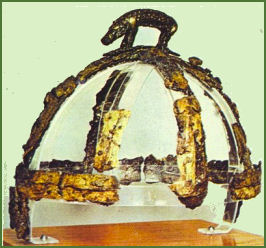 During archaeological excavations at an Anglo-Saxon tumulus or barrow on Benty Grange Farm, the famous Benty Grange helmet, one of the most important Anglo-Saxon artefacts ever unearthed in this part of the country, was discovered at Monyash in 1848.
During archaeological excavations at an Anglo-Saxon tumulus or barrow on Benty Grange Farm, the famous Benty Grange helmet, one of the most important Anglo-Saxon artefacts ever unearthed in this part of the country, was discovered at Monyash in 1848.
The excavation was led by the Derbyshire amateur archaeologist, Thomas Bateman (1821-1861). The remains of the helmet and a reconstruction are now on display at the Weston Park Museum in Sheffield.
The heavily corroded helmet dates from the mid-seventh century, the surviving iron bands of the helmet would once have supported plates of horn held in place with small silver rivets and the nasal plate is adorned with a silver cross. This helm is crested with an iron boar with bronze eyes inset with garnet, this sits upon an elliptical copper-alloy plate. The hips of the boar are made with pear shaped plates of gilded silver.
The 1986 reconstruction, based on conservation work carried out at the British Museum has boar bristles running along the back.
In ancient Norse mythology, the boar talisman was associated with Freyja's role as battle goddess, helmets with boar-crests are described in the Anglo-Saxon saga of Beowulf.
A walk to Lathkill Dale from Monyash
Distance- Around 4 miles
Duration- 2.5 hours
*Commencing at Fere Mere in the village of Monyash, proceed down Rakes Road to the left. On reaching a sharp right bend in the road turn left and walk down down Derby Lane. At a further sharp right bend continue straight on and go down the track.
*Continue down the track to reach One Ash Grange Farm and follow the footpath through the farm. Go through a small opening in the wall to enter a field, head east across the field and cross a stile and descend into Cales Dale. Continue along the track until reaching a junction with the Cales Dale path.
*Turn left and follow the track to Lathkill Dale. On reaching the valley bottom cross over the bridge and turn left, then proceed in a north westerly direction.
*The path will eventually rise, crossing a few fields before reaching a road. Cross the road and continue into Bagshaw Dale. Follow the dale until reaching a lane to return to Monyash.
Nearby places of interest
Chatsworth House known as "The Palace of the Peak" is the country seat of the Duke of Devonshire and is situated on the banks of the River Derwent, 3.5 miles to the northeast of Bakewell in the heart of the Peak District National Park.
Haddon Hall is an architectural gem. Dating back to the eleventh century, the hall has been described as "the most complete and most interesting house of [its] period", it is the finest example of a medieval manor house currently in existence in England.
Lathkill Dale, a Peak District beauty spot in the truest sense of the word, is one of Britain's finest limestone valleys, it is situated about 3 miles from the historic market town of Bakewell.
Arbor Low, sometimes referred to as ‘The Stonehenge of the North' is a prehistoric site of unique archaeological and cultural interest.
Dovedale a dramatic limestone ravine, with its impressive rock outcrops and tranquil woodlands is arguably the prettiest and most famous of the dales in the Peak District National Park
